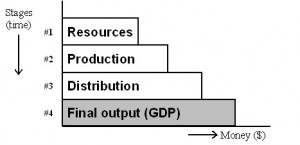Replacing Keynes: A New “General” Model of the Economy
“How can I possibly put a new idea into your heads, if I do not first remove your delusions?” — Robert Heinlein
Keynesian economics has created much mischief in the world — a bias toward inflation and easy money, chronic deficit spending, an anti-saving mentality, progressive taxation, big government and the welfare state.
Market-friendly economists have chipped away at the Keynesian monolith but have failed to displace Keynes’s “General Theory” that revolutionized the economics profession after World War II.
How do you replace a bad idea? Offer a better idea!
That’s why I wrote “Economic Logic,” the first comprehensive textbook that builds a new “general” model of the global economy drawn from the best ideas of the Austrian and Chicago schools.
I first start with my criticism of Gross Domestic Product (GDP), the number released every quarter by the government to measure economic performance of a nation. It originally was developed by Keynesian economist Simon Kuznets as a way to determine what Keynes called “final effective demand.” But it has a major defect. It measures final output only, therefore ignoring the supply chain and intermediate stages of production required to produce all of the finished goods and services.
Introducing a New General Model of the Economy
To remedy this defect, I created Gross Domestic Expenditures (GDE), a new statistic that adds up total spending at all stages of production. It turns out to be more than twice the size of GDP and proves that business investment (the supply side of the economy) is much bigger than consumer spending (the demand side of the economy).
Here below is the “general” 4-stage model of the economy. It is a universal model of the production process of all goods and services. It creates the balance between the “make” economy and the “use” economy that was missing under Keynes’s model. I consider it so important that I’ve printed it on the back cover of the latest 4th edition of “Economic Logic.”
Announcing the new 4th edition!
“Eureka! Skousen has done the impossible. Students love it! I will never go back to another textbook.”
–Professor Harry Veryser, University of Detroit-Mercy
I am happy to announce that the 4th edition of “Economic Logic” has just been released. It is divided into 28 lessons, or chapters, and is used as a primary textbook at more than a dozen major colleges and universities. It is completely updated, including new sections on:
–Whole Foods CEO John Mackey’s “stakeholder” model of capitalism, which has been incorporated into the stages-of-production process in chapter 3.
–The vital distinction between the “make” economy (Gross Domestic Expenditures or GDE) and “use” economy (Gross Domestic Product, or GDP) has been added to chapters 3 in microeconomics and 14 and 15 in macroeconomics.
–The slow level of job creation, the drop in the labor force participation rate and the sluggish recovery after the Great Recession, which are discussed in detail in chapters 10 and 25. Chapter 10 also addresses the unemployment crisis in Europe and America.
–New government regulations (Sarbanes-Oxley, Dodd-Frank, Securities and Exchange Commission) following the 2008 financial crisis and the Bernie Madoff fraud, which are discussed in chapter 13.
–The consumption and savings rate patterns of China are compared to those of the United States in chapter 17. This comparison helps to determine what drives the economy: consumer spending or savings/investment?
–The Federal Reserve’s “easy money” policies, featuring ZIRP (zero interest rate policy) and Quantitative Easing (QE), which are debated in chapter 19.
–The ongoing debate on “austerity” vs. “stimulus,” which has been added to chapter 22.
–The rise of state capitalism in China, which is highlighted in chapter 27.
–Economic terms that are defined in a glossary and added to this edition.
The new 4th edition of “Economic Logic” retails for $69.95, but you can get it for only $34.95, plus $5 for shipping and handling, by calling Eagle Publishing, 1-800/211-7661. Mention code ECON4. (For all purchases outside the United States, add an additional $10 for postage.)
You Blew It! Getting on Food Stamps is a ‘Snap’
At the Milken Conference back in April, I saw Michael Milken ask Senator Harry Reid what he would do about the monstrous growth in the welfare system in America, with a record 47 million Americans on food stamps… Oops, I mean Supplemental Nutrition Assistance Program, or SNAP, as the U.S. Department of Agriculture now calls it.
Senator Reid apparently thinks there is no welfare problem; in fact, he thinks we need to expand the food stamp program. “A lot of Americans go hungry and can’t get three squares a day,” he claimed.
So the government is encouraging Americans to sign up, and to tell them if they know anyone who needs food stamps.
One program is to encourage celebrities and CEOs to take the SNAP challenge and go on a food stamp budget for a week. Panera CEO Ron Shaich fell for the trap and will live on only $4.50 a day, the average daily benefit per person.
A number of politicians, including Newark Mayor Cory Booker, have taken the SNAP Challenge, publicly documenting their quest to eat on less than $5 a day (the weekly allowance is $31.50). The challenge has become a popular way to see how the other half lives, call attention to hunger issues and protest budget cuts.
Recently, Panera offered a “pay what you want” option at its St. Louis-area locations. At the time, Shaich said he hoped that the experiment would help customers who “say they only have three bucks in their pocket.”
If Panera expands this option nationwide, bankruptcy is not far behind and I will be shorting the stock.
Shaich wound up going with a carb-heavy shopping cart that included cereal, pasta, lentils and chickpeas, as well as an assortment of vegetables. He wound up spending $25.95, which only leaves him around $6 to spend on additional food for the rest of the week. We’re guessing he won’t be getting lunch at Panera during his week of taking the SNAP Challenge.
Of course, what Shaich and SNAP officials don’t tell you is that families can buy a lot more food in bulk than per individual, and that most of people on food stamps have other income to draw upon to buy food. People on food stamps also can go to many churches and non-profits for supplemental food, such as the Salvation Army, the Mormon Church or Food Banks located in every state of the union.
Whatever happened to self-dignity in this country and avoiding the dole?
Assistance needs to be temporary while people get back on their feet and start working. But government makes food, medicine, housing and other assistance permanent, so that today we have hundreds of thousands of Americans who are now fourth-generation welfare recipients.
What a travesty. And the sad thing is that our government (both Republicans and Democrats) are making it worse.
To read my e-letter from last week’s Eagle Daily Investor, please click here. I also invite you to comment about my column in the space provided below my Eagle Daily Investor commentary.
In liberty, AEIOU,

Mark Skousen
Wikipedia
Newsletter and trading services
Personal website
FreedomFest



